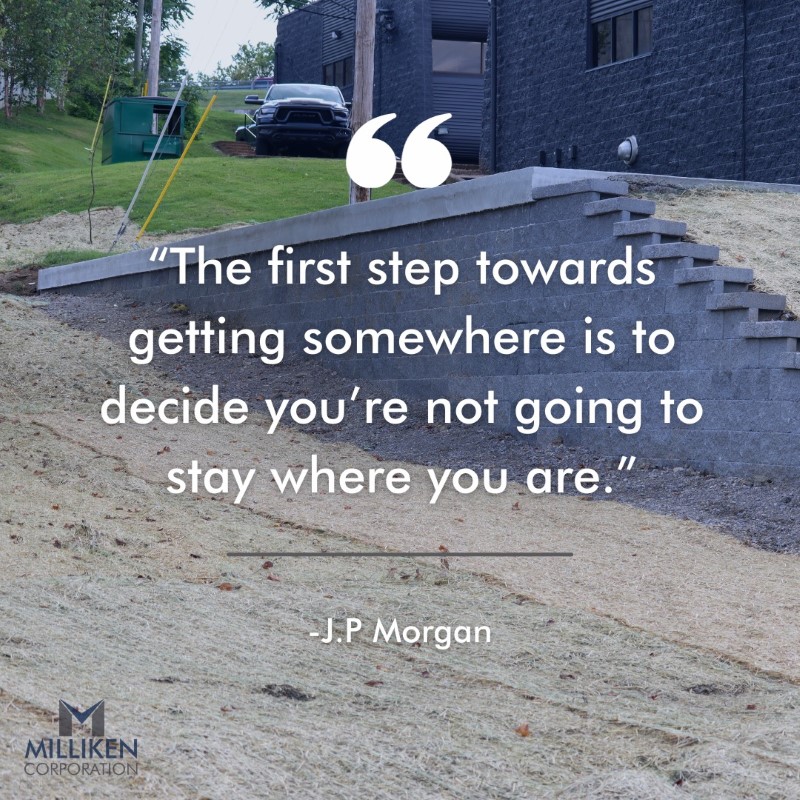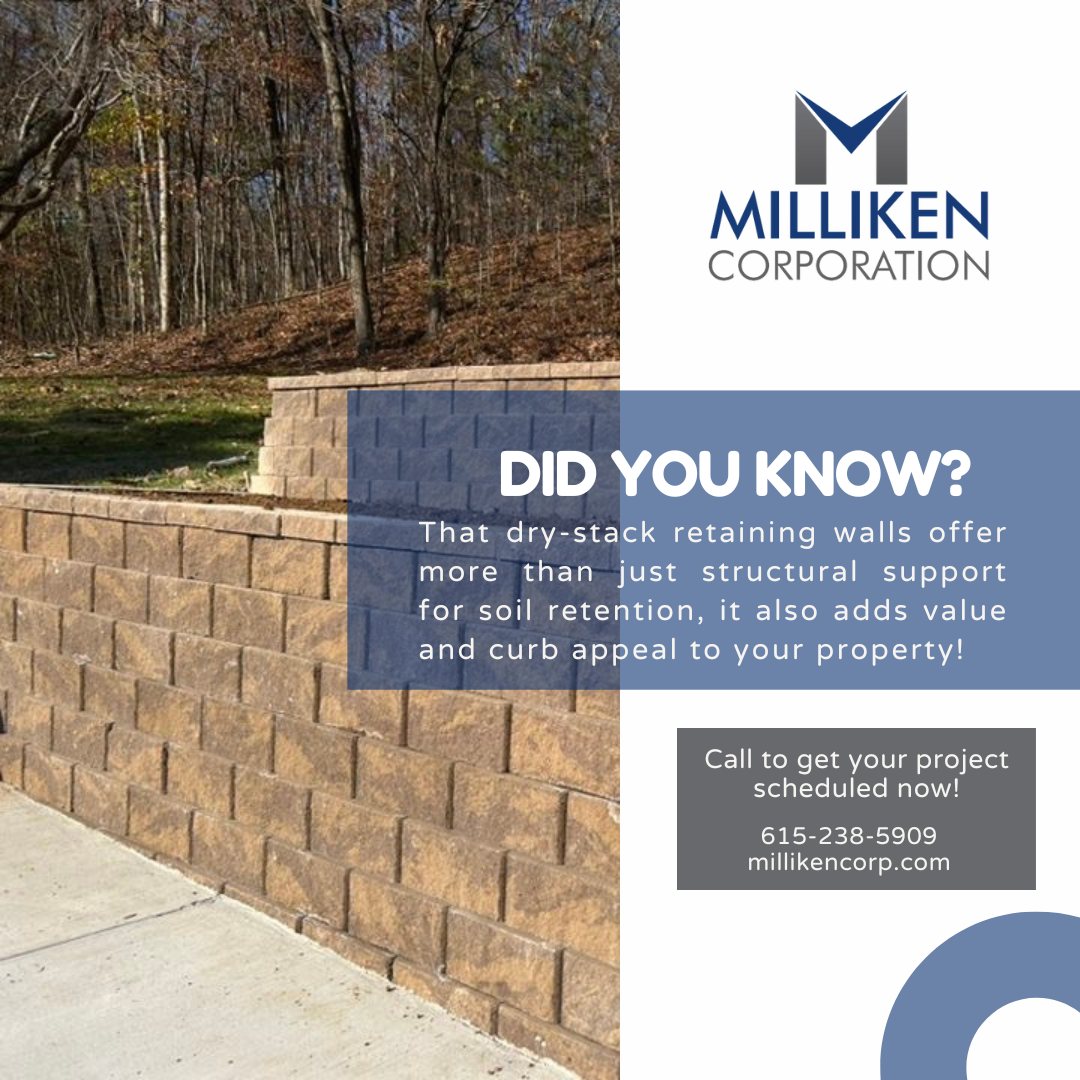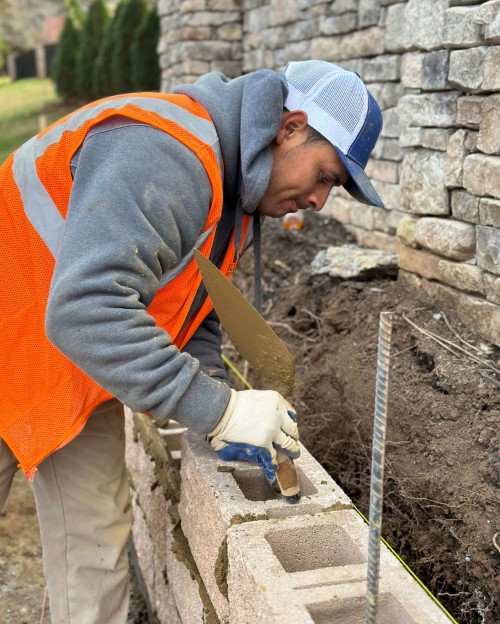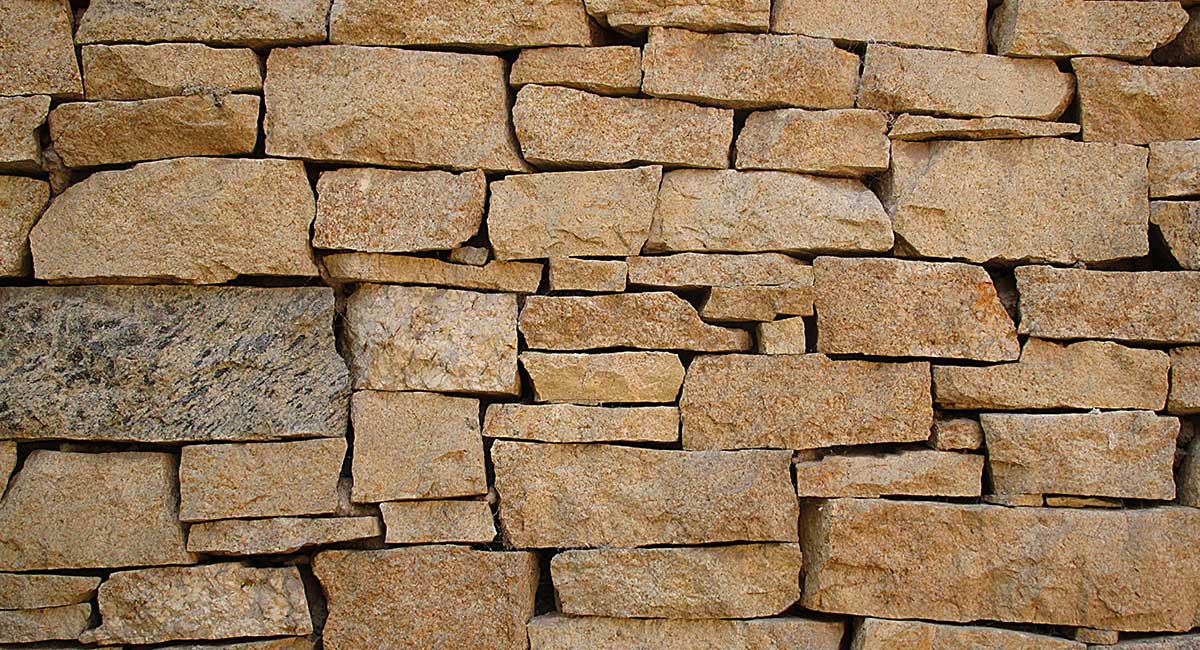Why might retaining walls be a smart choice for your landscape? Beyond their fundamental role in combatting erosion, these structures are pivotal in shaping usable terrains and enriching aesthetic appeal. This article explores the practical benefits of retaining walls for any landscape, from structural resilience to creating spaces that merge form and function, all while potentially elevating your property’s market worth.
Key Takeaways
- Retaining walls offer aesthetic enhancement for landscapes through a variety of materials and designs, doubling as functional elements like raised planters and soil erosion barriers.
- A key functional benefit of retaining walls is their ability to control erosion and stabilize soil, ensuring slope reinforcement, effective water flow management, and foundation protection.
- Beyond aesthetics and erosion control, retaining walls expand usable space by converting sloped terrains into functional areas for gardens, patios, or play areas, thus adding value to a property.
Enhance Your Landscape’s Aesthetics with Retaining Walls
Most people view retaining walls as mere functional barriers that hold back soil. However, these structures can also enhance your landscape, adding texture, depth, and distinctive characteristics. Alongside their aesthetic value, retaining walls also tackle specific landscaping issues, infusing unique character into your landscape. For instance, they can be utilized as raised planters for gardens, integrating function with visual appeal.
With a variety of materials and designs to choose from, retaining walls can be tailored to enhance the aesthetics of any landscape. We’ll delve into how retaining walls can enhance a landscape’s attractiveness.
Natural Stone Beauty
Natural stone retaining walls offer the following benefits:
- They exude a sense of durability and timelessness
- Materials like limestone, sandstone, and granite offer distinct textures and hues that can complement any landscape
- The diverse textures and colors of these stones allow retaining walls to blend seamlessly into the landscape, striking a balance between visual appeal and natural harmony.
Retaining walls can benefit from a wide variety of natural stones like fieldstones and flagstones, each adding a unique shape, size, and aesthetic to the structure. The resulting retaining wall can be a focal point of your landscape, a work of art that is as functional as it is beautiful.
Creative Designs and Patterns
Your imagination is the only limit to the design possibilities of retaining walls. Here are some design ideas to consider:
- Geometric patterns
- Alternating materials
- Straight lines for a formal garden appearance
- Flowing curves to emanate a softer, more organic landscape
Choose the design that best suits your style and adds visual interest to your landscape.
Incorporating a mix of rock sizes and colors can add unique visual appeal and personality to a garden, making each retaining wall design unique. The result is a retaining wall that not only serves a functional purpose but also adds a creative touch to your landscape.
Customizable Options
Retaining walls can be constructed from a diverse range of materials, including:
- Concrete
- Natural stone
- Brick
- Treated wood
- Innovative options like man-made stone veneer and Corten steel
This means you can personalize your retaining wall to match or contrast the existing environment and the architectural style of your property.
Some retaining wall materials feature self-locking flanges for swift installation and the potential for integrated lighting to enhance aesthetic and functional elements. The wide range of customizable options ensures that your retaining wall will be a perfect fit for your landscape.

Strengthen Erosion Control and Soil Stability
While the aesthetic appeal of retaining walls is undeniable, their functional benefits are equally important. One of the key benefits of retaining walls is their ability to prevent erosion and provide stability to filled materials, reducing the risk of landslides and soil erosion,.
Retaining walls serve multiple purposes, including:
- Holding soil in place to prevent erosion and soil washout
- Managing water flow during storms and heavy rainfall to reduce soil erosion and prevent flooding
- Reinforcing slopes to prevent landslides and slope failure
- Protecting foundations from soil movement and settling
In this post, we’ll explore how retaining walls aid in slope reinforcement, water flow management, and foundation protection.
Slope Reinforcement
Retaining walls are a great solution for landscapes with slopes or hills. A retaining wall requires a level base material and first layer of blocks to be structurally sound on a slope. Staggered joints in a retaining wall’s construction enhance its structural integrity and ability to hold back soil on a slope.
Backfilling with crushed gravel and tamping it after adding each level to the retaining wall ensures proper drainage and reinforces the wall against the slope. In a series of retaining walls on a slope, the upper wall should be equal to or shorter than the lower wall. The spacing should also be at least twice the lower wall’s height to minimize pressure.
Water Flow Management
Retaining walls play a crucial role in managing water flow. They can prevent soil runoff and erosion by holding back or redirecting water runoff, particularly during rainstorms or snowmelt. The design of retaining walls can include advanced drainage systems that effectively channel water runoff, reducing ground saturation and the risk of landslides.
Built-in drainage features like weep holes, gravel backfill, and drain pipes ensure efficient water management in retaining walls, guarding against moisture buildup near foundations. Proper drainage is essential for maintaining the structural integrity of retaining walls, preventing water from seeping into the backfill material and causing excessive pressure that could lead to wall failure.
Foundation Protection
Retaining walls provide crucial structural support that can protect the foundations of your property. They provide structural support for the surrounding soil, mitigating pressure and maintaining its stability. The stabilization of soil by retaining walls prevents erosion, which can lead to uneven settlement that compromises a property’s foundation stability.
Retaining walls have multiple benefits, including:
- Preventing soil erosion and protecting structures from damage
- Directing water flow away from building foundations
- Safeguarding against water damage
- Increasing the lifespan of structures
Professionally installed retaining walls can provide retaining wall benefits and more.

Expand Functional Space with Terraced Areas
Retaining walls can do more than just prevent erosion and enhance aesthetics. They can also convert sloped terrains into functional areas, providing level space for gardens, patios, or driveways. Terraced retaining walls enhance a landscape’s visual appeal by adding structure to problem slopes, which yields more usable outdoor space.
Through the creation of terraced areas, retaining walls offer several benefits:
- They maximize space efficiency, enabling the establishment of vibrant gardens and inviting entertainment spaces.
- Smaller, terraced or tiered retaining walls provide an attractive addition to landscape designs.
- They are found to be more appealing than a single large retaining wall.
We’ll discuss how retaining walls can be employed for vegetable and flower gardens, outdoor living spaces, or play areas.
Vegetable and Flower Gardens
Terraced retaining walls can be used to create terraced areas with multiple levels for planting, optimizing space and providing visual interest in the garden. They enable the creation of raised beds which allow for greater control over soil quality, making it ideal for vegetable and flower gardens.
Retaining walls can be integrated into stair designs, combining functional and design elements, and providing a focus to the garden with bright raised flower beds. They are also an effective way to delineate and separate different outdoor living areas, such as vegetable gardens or flower beds, from the rest of the yard.
Outdoor Living Spaces
Retaining walls can convert steep slopes into flat surfaces suitable for outdoor patios, creating more usable space for entertainment. Grading and retaining walls by experienced contractors can establish expansive outdoor patios, stairs, and driveways on slopes that would otherwise seem unusable.
Retaining walls can be constructed in creative ways such as integrating outdoor kitchens, water features, and gabion baskets filled with inorganic materials like rock or brick. They can incorporate seating areas or be integrated into outdoor living spaces, functioning as both a structural and a design element.
Play Areas and Recreation
Retaining walls can transform uneven terrain into flat surfaces suitable for play areas, as it creates usable land. They provide level ground necessary for children’s play spaces, mitigating potential risks associated with sloped landscapes.
The stability of a level surface provided by retaining walls enhances safety for children, reducing the hazards that uneven ground presents. By delineating specific play areas using retaining walls, not only is usable space maximized but also the defined areas help in supervising children effectively.
Boost Property Value and Curb Appeal
In addition to their functional and aesthetic benefits, retaining walls can also add significant value to your property. Installing retaining walls can increase the value of a home by up to 15 percent. The average return in resale from adding retaining walls is estimated to be between 100 to 200 percent.
Landscaping investments, including the addition of retaining walls, can add up to 20% to the value of a home. Retaining walls can set a property apart from others, enhancing its curb appeal and making it more attractive to potential homebuyers. We’ll explore in greater detail how retaining walls act as enticing landscaping features, boost property value, and offer a low-maintenance solution.
Attractive Landscaping Feature
By breaking up the monotony of a landscape, retaining walls make an attractive feature that significantly enhances a property’s curb appeal, distinguishing it from others. An eye-catching retaining wall can add a unique charm to your property, making it stand out in the neighborhood.
Whether it’s a terraced garden or a stone retaining wall that blends seamlessly with the landscape, retaining walls can significantly enhance the visual appeal of your outdoor space. They not only add aesthetic value, but also create functional spaces that can be used for different activities.
Increased Home Value
Landscaping improvements like retaining walls can add up to 20% to the value of a home, according to the American Society of Landscape Architects. The installation of a retaining wall adds aesthetic appeal and functionality, factors which are known to increase property value.
Enhancing the landscape with a professionally designed retaining wall may further increase the property’s market value due to improved appearance and functionality. Some benefits of adding a retaining wall to your property include:
- Improved appearance, making your property stand out in the housing market
- Increased functionality, providing additional usable space on your property
- Potential to attract more prospective buyers and facilitate a faster sale
Adding a retaining wall can be a great investment for your property, especially when a retaining wall constructed with high-quality materials and proper techniques is used.
Low Maintenance Solution
Retaining walls provide a durable and cost-effective landscaping option with minimal maintenance requirements for homeowners. Interlocking concrete blocks used in constructing retaining walls are a low-maintenance material choice, enhancing budget-friendliness without sacrificing durability.
Retaining walls made from natural materials are not only durable but also easy to alter or replace, further reducing long-term maintenance efforts. The built-in edging feature of terraced retaining walls reduces the need for frequent trimming, lowering the time and effort spent on landscape maintenance.

Ensure Longevity and Durability
The advantages of retaining walls include:
- Strength: Poured concrete is known as the strongest material for constructing retaining walls.
- Aesthetic appeal: Concrete retaining walls are preferred for their aesthetic appeal.
- Consistent performance: Concrete retaining walls are able to maintain consistent performance over time.
- Minimal maintenance: Retaining walls require minimal maintenance once installed properly.
- Longevity and durability: Retaining walls are robust, which assures their longevity and durability.
We’ll explore further how retaining walls offer longevity and durability through features like weather resistance, structural integrity, and professional installation.
Weather Resistance
Retaining walls are designed to withstand harsh weather conditions. Materials like concrete blocks or natural stone used in retaining walls are chosen for their durability to withstand harsh weather conditions without frequent repairs. They are engineered to endure environmental stresses such as:
- temperature fluctuations
- varying precipitation levels
- strong winds
- the impact of frost.
Ensuring durability against changing weather conditions involves:
- Choosing appropriate materials
- Incorporating proper drainage and waterproofing
- Using reinforcements and anchoring
- Adhering to construction codes and standards
Structural Integrity
Retaining walls need to be structurally sound to effectively hold back soil and prevent erosion. Ensuring that retaining wall construction complies with design codes and standards like those of the IBC and ASCE is essential for meeting safety requirements and maintaining structural integrity. Utilizing geosynthetic materials and anchoring systems as reinforcement techniques contributes to the stability and longevity of retaining walls.
A strong base and proper compaction methods, including the use of wall rock and compacting in lifts, are critical factors in establishing the durability of a retaining wall when it is constructed properly. Accurate data and effective communication during the design phase are vital to prevent underestimating the pressure a retaining wall must withstand.
Professional Installation
Professional installation is key to the stability and longevity of retaining walls. Hiring a professional company like Milliken for retaining wall installation is essential for protecting the house from soil erosion and ensuring stability. Proper installation involves comprehensive site analysis to ensure that the design and construction methods fit the specific conditions of the site.
Professional installation can include integrated retaining wall solutions that offer cost and time efficiencies, especially when part of a larger landscaping project.
Summary
In conclusion, retaining walls are a multifaceted addition to any landscape. They not only enhance the aesthetic appeal but also offer functional benefits like erosion control, slope reinforcement, and water flow management. They create usable spaces for gardens, patios, and play areas, increase property value and curb appeal, and ensure longevity and durability. Whether you’re looking to enhance your landscape’s aesthetics, create functional space, or boost property value, a retaining wall is a worthy investment.
Frequently Asked Questions
What is the primary purpose of a retaining wall?
The primary purpose of a retaining wall is to flatten sloped areas, preventing water and soil from flowing downward and making the area more accessible for pedestrians.
Are retaining walls a good investment?
Yes, retaining walls are a good investment as they provide functional and stylistic benefits, including erosion control and the creation of usable space, ultimately adding value to your property.
Is retaining wall good or bad?
Retaining walls are beneficial as they provide stability, protect against slope failures, and maximize usable space on sloping properties. A well-built retaining wall is worth the investment.
How can a retaining wall enhance the aesthetics of a landscape?
A retaining wall can enhance the aesthetics of a landscape by adding texture, depth, and distinctive characteristics, which can be personalized to complement or contrast the existing environment. This can create visual interest and improve the overall look of the landscape.
How does a retaining wall prevent erosion?
A retaining wall prevents erosion by holding soil in place, preserving the landscape, and managing water flow to reduce soil erosion during storms and heavy rainfall.

